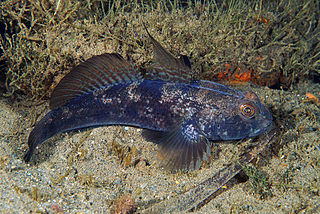
Gobiidae or gobies is a family of bony fish in the order Gobiiformes, one of the largest fish families comprising more than 2,000 species in more than 200 genera. Most of gobiid fish are relatively small, typically less than 10 cm (3.9 in) in length, and the family includes some of the smallest vertebrates in the world, such as Trimmatom nanus and Pandaka pygmaea, Trimmatom nanus are under 1 cm long when fully grown, then Pandaka pygmaea standard length are 9 mm (0.35 in), maximum known standard length are 11 mm (0.43 in). Some large gobies can reach over 30 cm (0.98 ft) in length, but that is exceptional. Generally, they are benthic or bottom-dwellers. Although few are important as food fish for humans, they are of great significance as prey species for other commercially important fish such as cod, haddock, sea bass and flatfish. Several gobiids are also of interest as aquarium fish, such as the dartfish of the genus Ptereleotris. Phylogenetic relationships of gobiids have been studied using molecular data.

Rhinogobius is a genus of primarily freshwater gobies native to tropical and temperate parts of eastern Asia. Most are small, streamlined in shape, and often sexually dimorphic. Few are of commercial importance, but R. duospilus is fairly widely traded as an aquarium fish.

The Gobiiformes are an order of fish that includes the gobies and their relatives. The order, which was previously considered a suborder of Perciformes, is made up of about 2,211 species that are divided between seven families. Phylogenetic relationships of the Gobiiformes have been elucidated using molecular data. Gobiiforms are primarily small species that live in marine water, but roughly 10% of these species inhabit fresh water. This order is composed chiefly of benthic or burrowing species; like many other benthic fishes, most gobiiforms do not have a gas bladder or any other means of controlling their buoyancy in water, so they must spend most of their time on or near the bottom. Gobiiformes means "goby-like".
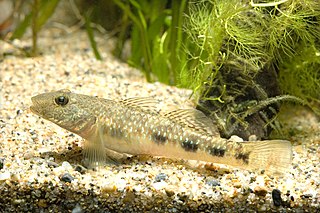
Rhinogobius giurinus is a species of goby native to eastern Asia where it inhabits marine, brackish and fresh waters of rivers and estuaries. This species can reach a length of 8 centimetres (3.1 in) TL. It is of importance to local peoples as a food fish.

The Ou River or Oujiang is the second-largest river in the Zhejiang province of eastern China. The river flows 388 kilometers (241 mi) before finally reaching the city of Wenzhou and emptying into the East China Sea, into which it discharges 20.2 billion cubic meters of water annually. Shen Jiang, Jiang Yongjia (永嘉江), and Wenjiang are all former names for this river.

True gobies were a subfamily, the Gobiinae, of the goby family Gobiidae, although the 5th edition of the Fishes of the World does not subdivide the Gobiidae into subfamilies. They are found in all oceans and a few rivers and lakes, but most live in warm waters. Altogether, the Gobiinae unite about 1149 described species in 160 genera, and new ones are still being discovered in numbers.

Oplopomus oplopomus, commonly known as the spinecheek goby, is a species of goby native to the Indo-Pacific region. They can grow to a maximum length of 10 centimetres (3.9 in). They inhabit coral reefs.

Rhinogobius flumineus, commonly known as the lizard goby or kawa-yoshinobori, is a species of goby endemic to Japan where it is found in the mid- to upper reaches of fast-flowing rivers. This species can reach a length of 7 centimetres (2.8 in) TL.

Wuyanling National Nature Reserve is a nature reserve in Taishun County, in the southern part of Zhejiang Province. The reserve occupies a mountainous, forested area. The highest peak is Baiyun Peak, which is 1,611 metres (5,285 ft) high.
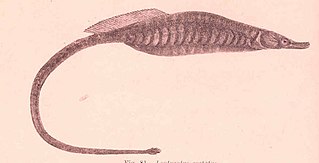
The deepbody pipefish is a species of pipefish endemic to Australia where it is only found along the southern coast. This species grows to a length of 12.9 centimetres (5.1 in) SL. This species is the only known member of the monotypic genus Kaupus which is named in honour of the ichthyologist Johann Jakob Kaup (1803-1873).
Rhinogobius aporus is a species in the goby subfamily Gobionellinae endemic to China. It was first described as Pseudorhinogobius aporus, but that genus has been brought into synonymy with Rhinogobius.
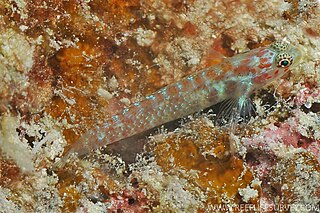
Eviota melasma, commonly called headspot eviota or melasma pygmy goby among various other vernacular names, is a species of marine fish in the family Gobiidae.

Lutjanus malabaricus, the Malabar blood snapper, saddletail snapper, large-mouthed nannygai, large-mouthed sea-perch, Malabar snapper, nannygai, red bass, red bream, red emperor, red Jew, red snapper, saddletail seaperch, scarlet emperor or scarlet sea-perch, is a species of marine ray-finned fish, a snapper belonging to the family Lutjanidae. It is native to the Indian Ocean and the western Pacific, where it is found east to Fiji and Japan.

Polysteganus praeorbitalis, the Scotsman or Scotsman seabream, is a species of marine fish in the seabream family (Sparidae) of order Perciformes. It is native to Southern Africa.
Rhinogobius wuyanlingensis is a freshwater goby native to Wuyanling National Nature Reserve in Zhejiang Province, China. It is probably endemic to the upper reaches of the Feiyun River Basin.

Rhinogobius zhoui, known as Zhou's scarlet goby in the aquarium trade, is a species of freshwater goby from the subfamily Gobionellinae which was discovered in a stream on Lianhua Mountain in Haifeng County, Guangdong Province, China. This goby also native in the other part of Guangdong Province and Guangxi Province, for some similar described species,which are called Resemble Zhou's Rhinogobius (类周氏吻虾虎) and New Red Rhinogobius (新红吻虾虎) in China, are found in streams of those places.
Papuligobius uniporus is a species of small goby in the subfamily Gobionellinae. It is also the type species of the genus Papuligobius.
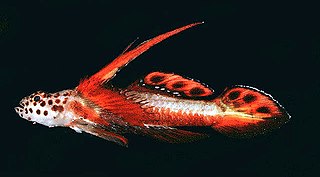
Discordipinna griessingeri is a small, brightly colored, marine neritic fish in the family Gobiidae that is commonly called the spikefin goby or flaming prawn goby. Occasionally it is mislabeled as "Stonogobiops griessingeri" which is a binomial species name that does not formally exist. The spikefin goby has a wide distribution across reefs throughout the western tropical Pacific, Pacific Islands such as Hawai'i or Polynesia, the Indian Ocean, and the Red Sea. It is also occasionally collected and traded as an exotic aquarium fish in multiple countries.
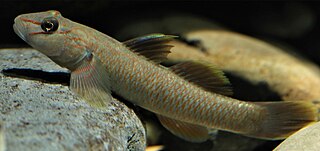
Rhinogobius candidianus is a species of freshwater goby. It is endemic to Taiwan.
Boleophthalmus birdsongi, also known as Birdsong's goggle-eyed goby, North Australian great mudskipper, and Birdsong's mudskipper, is a species of mudskipper. It occurs in the mudflats of Northern Territory, Australia.


















